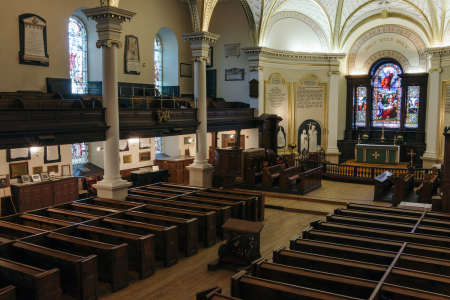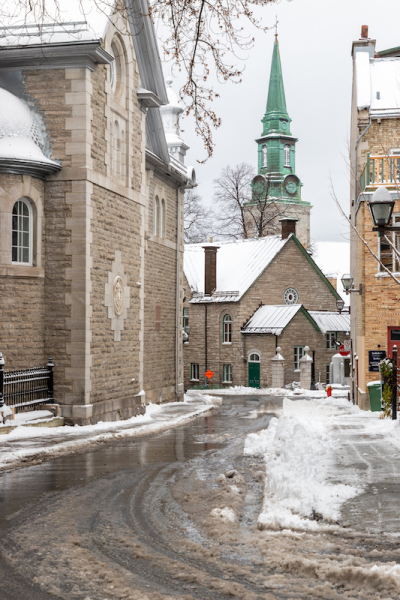Religion intertwined with history in Quebec City

There aren’t many places in North America with the history and religious heritage of Quebec City.
The capital of the eponymous Canadian province was founded in 1608 by legendary French explorer Samuel de Champlain. While the city owes its existence to Champlain, who made it the seat of colonial New France, another Frenchman, Jacques Cartier, first came ashore here in 1535. Cartier is also credited with giving Canada its name.
Over the ensuing decades and centuries, Quebec City served as the base for further French exploration of the continent. Central to the expansion of the fleur-de-lys was the cross of the Roman Catholic church.
By the time of the Seven Years’ War, a world war started by George Washington that today is largely forgotten, New France’s territory included all or parts of several present-day U.S. states, including Missouri and lands west of the Mississippi River. All this changed in 1759, when the British under Gen. James Wolfe captured the city. This victory was seminal in France’s defeat and ceding of its possessions, including all of Canada, at the war’s end in 1763.
With the British conquest came the Protestantism of the established Church of England.
But the Anglican state church never emerged from the shadow of Roman Catholicism, which Britain came to tolerate as it focused on a political movement that eventually became the American Revolution. That toleration included religious freedom for French Canadians and the restoration of tithes.

While Britain retained imperial control until 1926 — some vestiges remain as the British monarch is also Canada’s head of state — Quebec City looks and feels French. French is the province of Quebec’s official language, the menus of many restaurants are French or a distinct hybrid of French and Quebecois cuisine, and the culture shares the same kind of secular characteristics as France.
Throughout the centuries one aspect of life in the city and, by extension, the province remained constant: the church. Visible reminders of this can be seen everywhere in Old Quebec, as the UNESCO World Heritage-listed old town is called.
The major sight is the Our Lady of Quebec Basilica-Cathedral, seat of the Roman Catholic archbishop of Quebec and primate of Canada. The neoclassical edifice stands opposite City Hall.
Originally built in 1647, the cathedral with its west front adapted from the Church of St. Stephen of the Mount in Paris has been enlarged several times and twice rebuilt. First after the British bombardment of the city in 1759 and again when a blaze gutted the interior in 1922. With a holy door — last opened during a jubilee year in 2015 — and the tomb of Monsignor François de Laval, first bishop of Quebec, propagator of the faith across New France and, since 2014, a canonized saint, it is popular with pilgrims.
A short walk away stands the Cathedral of the Holy Trinity, the first Anglican cathedral outside the British Isles.
Architecturally, Holy Trinity looks more like a parish church. Built between 1800 and 1804, it’s somewhat unique in that it was never rebuilt in the Gothic revival style that dominated the second half of the 19th century. Beyond the interior reminiscent of London churches is a museum-worthy silver communion set and altar candlesticks gifted by King George III, who created the Anglican bishopric in 1793.
Alongside Quebec City’s two cathedrals are current and former monasteries, which for centuries operated schools and hospitals.
One such example is the Monastery, a former religious community of Augustinian nuns. Dating to 1639, the convent was carefully converted in recent years to a nonsectarian retreat center with the kind of finishes one expects of an upscale boutique hotel. The comprehensive museum is a must visit destination.
If you go
Some sights are closed or have limited visitor hours outside the peak summer season. The best and most reliable time to visit the cathedrals is during the regularly scheduled Sunday services at 9:30 a.m. (Roman Catholic) and 11 a.m. (Anglican).
Consider a walking tour from Maple Leaf Tourism Services. Among the several itineraries is a religious heritage tour.
Be sure to also see the Basilica of St. Anne of Beaupre, which is located about 20 minutes by car from Quebec City in Beaupre. Dedicated to the mother of the Virgin Mary, the monumental shrine was rebuilt in the early 1920s and features one of the most stunning interiors anywhere in North America.
Stay at the Fairmont Le Château Frontenac, a throwback to the grand hotels from the turn of the last century.
Flying to Quebec City’s airport requires a connection in either Toronto or Montreal. Canada is fully open for vaccinated Americans. Quebec requires a vaccine passport — the paper Centers for Disease Control and Prevention card is accepted — for many activities, including dining in restaurants.
Dennis Lennox writes a travel column for The Christian Post
Dennis Lennox writes about travel, politics and religious affairs. He has been published in the Financial Times, Independent, The Detroit News, Toronto Sun and other publications. Follow @dennislennox on Twitter.





















